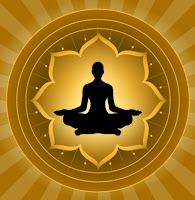By Faye Martins
A stroke by definition is when a
blood clot interrupts blood flow to the brain, causing brain cells to die. This
results in a number of impairments to movement, speech, and memory. A stroke
changes the world of its victims overnight, forcing them to relearn movements
and abilities that once came naturally. The effects of a stroke can vary
widely, depending on where it has occurred in the brain. Patients recovering
from a stroke can benefit from the gentle postures and breathing of yoga. Most
standing yoga poses can easily be adapted, since stroke victims must remain in
a sitting or lying position. As they gain strength and dexterity, they can
stand next to or behind the chair for balance.
Benefits
Yoga is naturally a gentle form of exercise that isn't jarring on the joints. People recovering from a life-altering injury such as a stroke aren't able to perform rigorous exercises, but can still perform a number of yoga poses that will improve with time. Studies on stroke victims who practice yoga on a regular basis show improvements in coordination, strength, balance, fine motor skills, and overall dexterity. Patients should practice on a regular basis with a trained professional yoga instructor, preferably one with a focus on rehabilitation.
Adaptations
Any of the yoga poses can be adapted for sitting in a chair, leaning against a wall, or lying on the floor. The students will stain gain the benefits that will help them heal, such as increased blood flow throughout the body, increased strength and flexibility, better coordination, and improved dexterity. Students should remember to always keep the neck in line with the spine, and to keep the head above the hips. A gentle practice is best at first, until the student gains more strength and balance. Yoga instructors should always be gentle and patient with students who are recovering from a stroke.
Breathing and Meditation
How to become a yoga instructor for stroke victims requires study, practice, and compassion. The process of healing from a stroke is mental as well as physical. Stroke victims often go through a type of grieving process over the loss of their abilities and their lives as they once knew them. This can result in anger, frustration, fear, and uncertainty. Deep belly breathing and meditation can relieve many of these issues. Teach stroke patients to breath deeply, filling up both the right and left sides of the body. Teach them to practice mindfulness by focusing on the present moment, and letting go of negative thoughts and emotions.
Benefits
Yoga is naturally a gentle form of exercise that isn't jarring on the joints. People recovering from a life-altering injury such as a stroke aren't able to perform rigorous exercises, but can still perform a number of yoga poses that will improve with time. Studies on stroke victims who practice yoga on a regular basis show improvements in coordination, strength, balance, fine motor skills, and overall dexterity. Patients should practice on a regular basis with a trained professional yoga instructor, preferably one with a focus on rehabilitation.
Adaptations
Any of the yoga poses can be adapted for sitting in a chair, leaning against a wall, or lying on the floor. The students will stain gain the benefits that will help them heal, such as increased blood flow throughout the body, increased strength and flexibility, better coordination, and improved dexterity. Students should remember to always keep the neck in line with the spine, and to keep the head above the hips. A gentle practice is best at first, until the student gains more strength and balance. Yoga instructors should always be gentle and patient with students who are recovering from a stroke.
Breathing and Meditation
How to become a yoga instructor for stroke victims requires study, practice, and compassion. The process of healing from a stroke is mental as well as physical. Stroke victims often go through a type of grieving process over the loss of their abilities and their lives as they once knew them. This can result in anger, frustration, fear, and uncertainty. Deep belly breathing and meditation can relieve many of these issues. Teach stroke patients to breath deeply, filling up both the right and left sides of the body. Teach them to practice mindfulness by focusing on the present moment, and letting go of negative thoughts and emotions.
© Copyright 2012 –
Aura Wellness Center – Publications Division
To find courses about how to become a yoga instructor, please visit the following link.
FREE Yoga Report. FREE
Yoga Newsletter. FREE Yoga Videos. Free Podcasts. Bonus: Free Yoga e-Book,
“Yoga in Practice.”
FREE CONTENT: If you
are a Yoga Teacher, Yoga studio, blogger, e-zine, or website publisher, and are
in need of quality content, please feel free to use my blog entries (articles).
Please be sure to reprint each article, as is, including the resource box
above. Namaste!

No comments:
Post a Comment